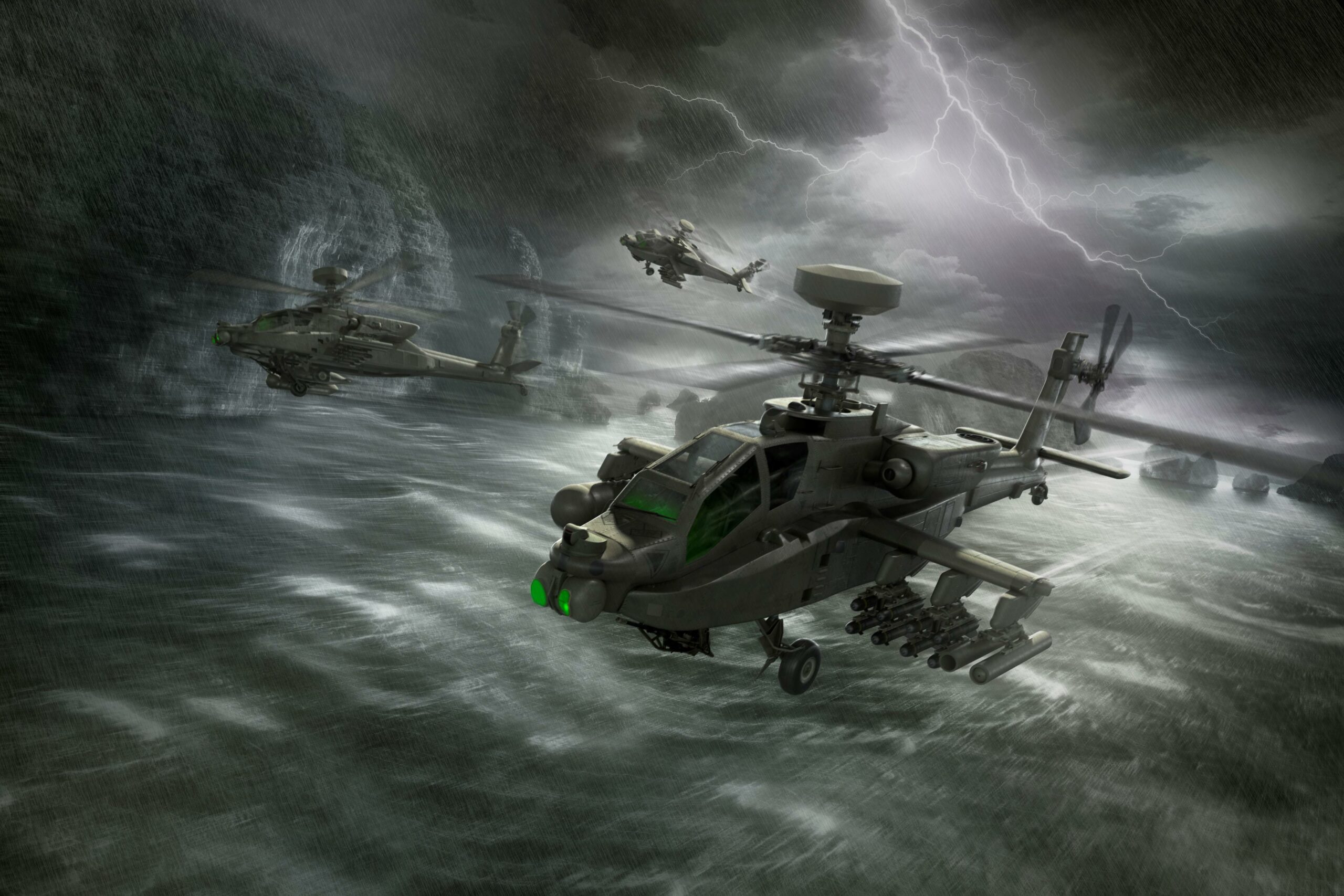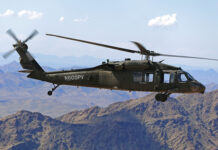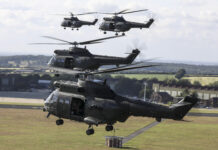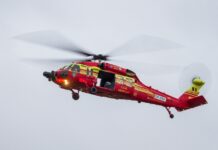Much attention is paid to the US Army’s recent contract award to develop and field the Future Long Range Assault Aircraft (FLRAA). However, the Army also continues to procure several legacy manned rotary aircraft systems.
While every helicopter category in the US Army inventory has undergone numerous overhaul, upgrade or even rebuild phases, the basic design of the major aircraft types can be traced back to the Vietnam War era. In 2009 the Army initiated the Future Vertical Lift programme to investigate technologies and concepts for a new generation of rotary aircraft with enhanced “manoeuvrability, range, speed, payload, survivability, reliability, and reduced logistical footprint” compared with current aircraft classes. Within a few years the service devised a plan encompassing five categories or “capability sets” ranging from a light reconnaissance helicopter to an ultra-heavy rotary airlifter with more payload capacity than a C-130, with the latter to be fielded by 2025. This agenda and timeline were soon recognised as overly ambitious. While the five categories have not been officially abandoned, the Pentagon has opted to concentrate on fielding two medium-lift FVL platforms, namely the Future Long-Range Assault Aircraft (FLRAA) and the Future Armed Reconnaissance Aircraft (FARA).
FLRAA
The FLRAA medium-lift utility helicopter will augment and ultimately replace a portion of the UH-60 Black Hawk fleet, progressively assuming the most challenging missions. The Pentagon conceives the FLRAA as a high-speed, long-range aircraft that will be survivable in contested environments. The intended premier mission will encompass assault transport and support of airmobile infantry, whereby the aircraft’s improved speed and range will permit staging assault operations from distributed locations and from beyond the reach of enemy long-range fires. Intra-theatre aeromedical evacuation (MEDEVAC) will be another vital battlefield mission.
On 5 December 2022 the Army announced the selection of Bell Textron to design and build the FLRAA. Bell’s V-280 Valor technology demonstrator, which had been submitted for the preceding Competitive Demonstration and Risk Reduction (CD&RR) phase of the programme, will form the basis of the future aircraft. The tiltrotor V-280 meets or exceeds the Army’s FLRAA performance prerequisites, achieving over 555.6 km/h (300 knots per hour) during CD&RR testing and promising a combat range of up to 1,281.6 km (800 NM). The aircraft has a crew of four (two pilots and two loadmasters) and carries up to 14 combat equipped passengers, enough for a full squad plus support or specialist personnel.
Since May 2021 the Army has been pursuing a Middle Tier of Acquisition (MTA) approach to the FLRAA programme. As defined by the US Department of Defense (DoD), the MTA pathway is devised for technologies considered sufficiently mature to be rapidly prototyped within an acquisitions programme, or fielded, within five years of MTA programme start.
The initial contract awarded in December 2022 is the beginning of a structured approach which will run through the remainder of the decade. The 19 month phase encompassing 2023 and the first half of 2024 will be dedicated to continued preliminary digital design development followed by detailed design, development and delivery of virtual prototypes. This phase is valued at up to USD 1.3 Bn, with the first tranche coming to USD 232 M.
On 28 December 2022, Sikorsky formally contested the contract award. The Government Accountability Office has 100 days to either confirm the contract award or re-open competition. The Army has confirmed that the programme timeline factored in the possibility of a protest, and that any related delays would not impact the overall development cycle.
The Army is currently developing a Test and Evaluation Master Plan (TEMP) to support a Milestone B decision in late FY 23, enabling transition to an Acquisition Category 1B programme managed by the Army’s acquisition authority. Physical prototype build is slated to begin in late FY23, with prototype delivery and flight testing to begin in 2025. A Limited User Test (LUT) to address any issues encountered during flight testing is expected in FY27, followed by a Milestone C decision in FY28. Operational fielding of the first Low-Rate Initial Production (LRIP) units and a Full Rate Production (FRP) decision are both slated for FY30. The Army’s projected budget for the engineering and manufacturing development (EMD) phase, testing and LRIP is USD 7.1 Bn. Total procurement – over several decades and including foreign military sales – could eventually be valued at USD 70 Bn.
FARA
In 2020 the Pentagon described the FARA as Army Aviation’s number one priority. FARA’s primary mission will be armed reconnaissance. Since retirement of the OH-58 Kiowa Warrior helicopter in 2013, that role has been delegated to the AH-64E Apache attack helicopter and the (unarmed) RQ-7 Shadow UAV. FARA will fill a critical capabilities gap and permit the Apache fleet to concentrate on the attack mission, while offering significantly greater range and manoeuvrability than the RQ-7. The armed reconnaissance aircraft, sometimes referred to as an airborne ‘knife fighter,’ is expected to neutralise enemy air defence assets and sensors, clearing the path for the more heavily armed Apache attack helicopters or for FLRAA carrying assault infantry. Weapons options are expected to include both kinetic ordnance and electronic warfare capabilities. The improved tactical reach offered by FARA is expected to permit aerial attack operations to be launched from beyond enemy sensor and weapons range.
The Army requires FARA to operate in complex and dense urban, mountainous, desert, jungle and maritime environments. Few specific parameters for the aircraft have been set to date, aside from dimensions (maximum rotor diameter and fuselage length of 12 m to enable urban operations below rooftop level) and a required airspeed capability of at least 333.4 km/h (180 knots). More specific requirements are currently being developed and will be included in the final Capabilities Development Document (CDD) to be presented for approval to the Army Requirements Oversight Council during FY23.
The two remaining contenders for the FARA programme are Bell Textron and Sikorsky. Bell Textron has designated its FARA concept the 360 Invictus. It employs a single four-blade rotor system and a tilted, shrouded tail rotor. Stub wings provide extra lift at medium to high speeds. Sikorsky’s concept is based on the S-97 Raider technology demonstrator, and is designated the Raider X. The most visible aspect is the coaxial rotor blade design coupled with a pusher propeller. The side-by-side cockpit layout is also unconventional for an attack and scout helicopter.
The Army’s decision to pursue two major helicopter development programmes – the FLRAA and FARA – nearly simultaneously has always been considered daring. As of this time the FARA programme is behind the envisioned schedule, largely due to COVID-associated delays in delivering the new General Electric T901 turboshaft engine developed under the government’s Improved Turbine Engine Programme (ITEP). The Pentagon has mandated that both contenders use the new engine in their designs. Competitive flight testing of the technology demonstrators cannot proceed until the T901, which first became available in November 2022, can be installed.
Evaluation of the engineering manufacturing and development (EMD) proposals of both contenders is ongoing. The fly-off competition between the ITEP-equipped concept aircraft is expected to proceed in FY23. A Milestone B decision leading to award of the EMD contract to one competitor is scheduled for the first quarter of FY24. The actual EMD phase is expected to run through the end of FY28, with fielding of LRIP aircraft to operational units circa 2030. As with FLRAA, FARA’s FRP is expected to begin in the early 2030s.
AH-64v6 Apache
The US Army currently operates the Apache attack helicopter in the AH-64D Longbow and AH-64E Guardian variants. The AH-64E continues to be procured in the Version 6 configuration (AH-64Ev6) which began fielding in 2021. The v6 is optimised for service-specific and joint-force multi-domain operations (MDO). The network-centric configuration boasts numerous upgrades to navigation, sensors, targeting and weapons capabilities, including the ability to exchange sensor and targeting data via Link-16 with external platforms in a joint operational setting. The Guardian’s Manned-Unmanned Teaming (MUM-T) ability is another force multiplier, enabling reception of Unmanned Aerial Vehicle (UAV) video in the Apache cockpit, control of UAV sensors by the helicopter’s crew, and control of the UAV flight path.
Deliveries of the AH-64Ev6 are expected to be continue into FY28, with a projected service life into the 2060s. In 2022 Boeing introduced a concept for a Modernised Apache as the next evolution of the AH-64Ev6. Boeing promises drivetrain upgrades to fully utilise the ITEP engine’s potential; advanced mission systems to increase interoperability to the network and to reduce pilot cognitive strain and workload; advanced sensors and sensor fusion for better and more resilient cross-domain connectivity; airborne long-range precision munitions, Air Launched Effects (ALE), electronic warfare and (potentially) future directed energy weapon system integration; and advanced sustainment through a more capable and lower life cycle cost airframe. Models and concept art released by Boeing feature extended wings with three pylons each rather than the current two. To date the Army has not announced plans to procure this future variant.
UH-60M/V Black Hawk
Despite the pending introduction of the FLRAA, the Army plans to continue operating the UH-60 Black Hawk family of utility tactical transport helicopters for several more decades. The current fleet encompasses numerous variants, including the UH-60L (produced 1989-2007) and the UH-60M which has been in continuous production since 2006. Additionally, the UH-60V programme will systematically upgrade existing ‘L’ variant aircraft to the more advanced ‘M’ model’s digital cockpit configuration. Both the ‘M’ and ‘V’ variants are digitally networked and capable of supporting joint-force operations.
Sikorsky’s parent company Lockheed Martin has announced future upgrades to the UH-60, including the performance enhanced GE T901 turbine engine to increase lift and range; advanced digital vehicle management systems supporting degraded visual environment and automated operations; and digital tools including predictive analytics that reduce aircraft downtime and maintenance costs. Modular Open Systems Architecture (MOSA) will permit rapid integration of emerging technologies to increase flight performance and maintain operational relevance in the future.
The most recent UH-60M multi-year procurement contract was signed in June 2022. Sikorsky will deliver a total of 120 aircraft through 2027. Under this contract, the government retains an option for an additional 135 helicopters to be distributed as needed to the Army, civilian agencies, or foreign military sales. The US Army’s current Black Hawk fleet of 2,100 aircraft includes circa 1,200 UH-60M, with a stated ultimate procurement goal of 1,375 units of the ‘M’ variant.
The UH-60V completed initial operational test and evaluation (IOPE) in August 2022, following delays attributed to both the COVID pandemic and to initial software reliability issues. LRIP was authorised in 2020, enabling equipment of a National Guard aviation unit to perform the IOPE under operationally realistic conditions. A decision on FRP is pending and expected soon. The planned conversion rate of 48 ‘L’ model helicopters to ‘V’ variants per year is considered too slow, given the current UH-60L inventory of 760 units. The Army is reportedly seeking ways to speed up the process, however, options are likely to be limited by budget constraints.
UH-72B Lakota
In 2006 the US Army selected a militarised variant of the Eurocopter (now Airbus Helicopters) EC-145 to serve as the new light utility helicopter. FRP for the new aircraft, designated as the UH-72A Lakota, was approved in 2007, leading to delivery of 463 units through 2020. In 2020 the Army placed an initial order for 18 units of the upgraded UH-72B variant. The UH-72B has improved performance, due to the stronger Arriel 2E engine, the use of a bearingless five-bladed rotor in place of the ‘A’ model’s four rotor blades, and a shrouded fenestron tail rotor which also enhances safety on the ground. The ‘B’ variant also features enhanced cockpit controls, the Airbus Helionix avionics suite, and an auxiliary operator’s console for centralised control of sensors and the ground data link. Deliveries began in September 2021.
The active duty Army uses the UH-72A for pilot training at the Army Aviation Centre at Fort Rucker, Alabama. The remaining UH-72A and the UH-72B are assigned operationally to the Army National Guard (ARNG). Both variants are unarmed and have the same mission profile which includes general cargo and personnel transport, disaster assistance, search and rescue (S&R), MEDEVAC, command and control, border surveillance and counter-drug operations.
CH-47F/MH-47G Chinook
The CH-47F procured during the first two decades of the millennium is the most recent variant of the Chinook helicopter family. The heavy-lift aircraft conduct a full spectrum of operations including assault transport, S&R, MEDEVAC, and heavy equipment (vehicle, artillery) transport. The Army is planning to acquire a CH-47F Block II version with an improved power train and rotor system, software and avionics upgrades, a strengthened fuselage and a redesigned lightweight fuel system. These changes promise increased speed and range when compared to the Block I version.
CH-47F Block II is an acquisition category IC programme led by the Army’s Programme Executive Office (PEO) Aviation. Progress is behind the original schedule following cancellation of a limited user test in FY21 due to technical problems during testing, and the subsequent cancellation of a Milestone C decision planned for late FY21. The Army is currently redefining system requirements which were originally defined in a FY16 TEMP.
One major change is the decision, taken in 2021, to abandon development of the Advanced Chinook Rotor Blades (ACRB) which had been expected to significantly improve lift, but which created unresolvable vibration issues during testing. The Army now plans to utilise the legacy fibreglass rotors already used on the Block I configuration.
In 2022 the PEO Aviation, Brig. Gen. Robert Barrie, announced that the remainder of the Block II system upgrades were on track, and that qualification efforts were resourced through 2023. In 2021 the Army awarded Boeing a contract for four production model CH-47F Block II aircraft to be delivered beginning in 2023, with the goal of outfitting an operational unit in 2025. An additional two aircraft were ordered in October 2022, with an advanced procurement contract for a third lot being prepared.
The Pentagon’s Director of Operational Test and Evaluation (DOTE) report issued in January 2023 is more restrained than the PEO, referring to the future of the CH-47F Block II as “uncertain.” As of January 2023 the DOTE was awaiting the Army’s updated acquisition strategy and an update on planned aircraft configuration, information the testing office needs in order to devise a new testing strategy and TEMP. The report notes that operational testing is not currently scheduled. This is likely to change following delivery of the LRIP aircraft.
The service is also procuring an upgraded special operations variant of the Chinook. The MH-47G Block II has 1,800 kg additional load capacity and increased range thanks to improvements including newly designed rotor blades and a more efficient drivetrain, The first MH-47G Block II aircraft was delivered in the fourth quarter of FY20. Contracts to date cover delivery of 36 of the upgraded helicopters for the Army Special Operations Command. The ultimate procurement goal is 69 MH-47G Block II.
Unmanned/Optionally Manned
Armed forces are displaying significant interest in optionally-manned systems, and US Army aviation is no exception. On 5 February 2022, a Black Hawk helicopter outfitted with the ALIAS (Aircrew Labor In-cockpit Automation System) performed its first unmanned flight over Fort Cambell, Kentucky. The 30 minute flight was part of a Defense Advanced Research Projects Agency (DARPA) programme carried out in conjunction with Lockheed Martin. Lockheed’s subsidiary Sikorsky produces the MATRIX Technology system which forms the core of DARPA’s ALIAS project. The flight control system can be temporarily mounted on various rotary and fixed-wing aircraft types, and removed again when autonomous capabilities are no longer required. According to DARPA, ALIAS aims to support execution of an entire mission from takeoff to landing, including autonomously handling contingency events such as aircraft system failures. The AI is also equipped to handle flight operations under severely degraded visibility as well as congested or contested airspace.
DARPA has stated that the primary goal is not to create dedicated unmanned variants of manned aircraft, but to relieve overburdened flight crews so they can concentrate on mission management. ALIAS could thus support a human aircrew, or serve as a virtual co-pilot for a single aviator in a two-seat cockpit. However, multiple flights conducted in October 2022 during the Project Convergence 22 experiment demonstrated that an ALIAS-equipped Black Hawk could carry out autonomous supply flights as well as unmanned casualty evacuation missions. Merging the payload and flight performance of the UH-60 with autonomous operations could enhance future logistical support to frontline forces while reducing the risk to human aircrews.
While not yet an acquisition programme of record, ALIAS or a similar modular autonomous flight control system – which goes far beyond standard ‘automatic pilot’ systems in today’s cockpits – could expand options for all the manned helicopter types currently being procured.
Sidney E. Dean









